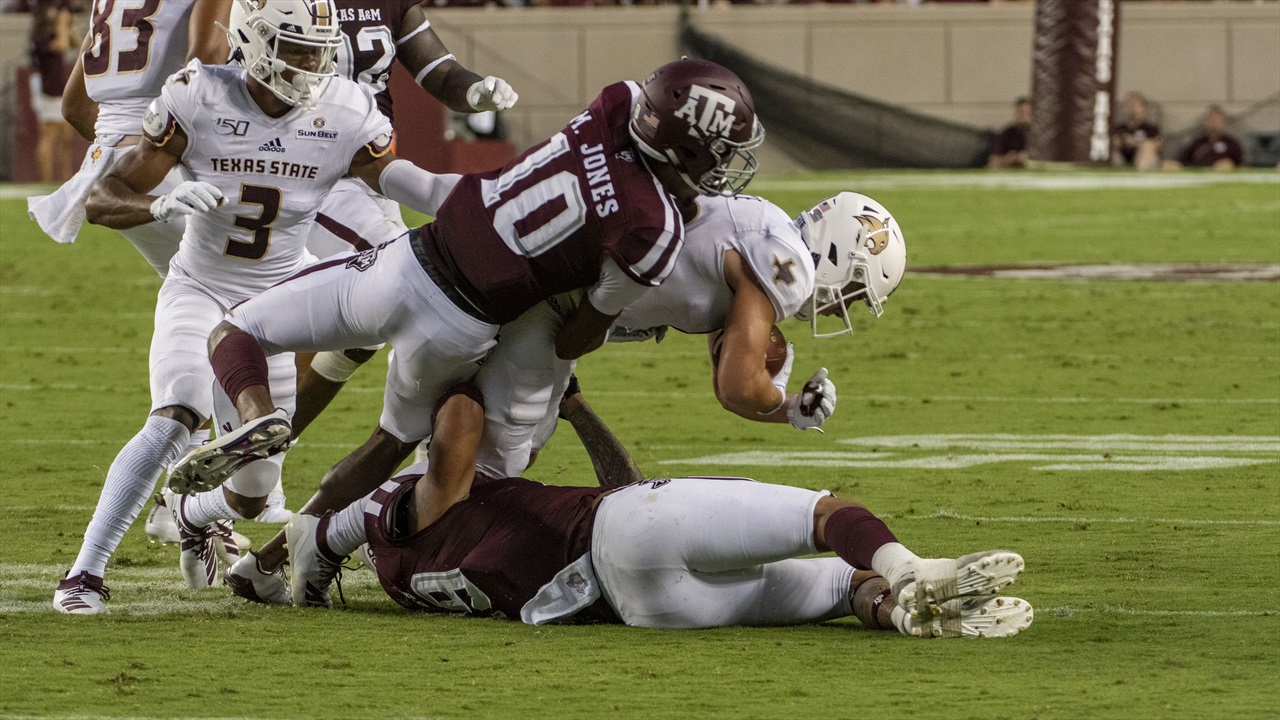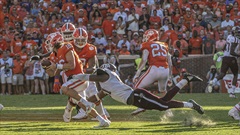Your previous article about 2nd year coaches did similar. I think I saw one of the national writers copy that theme (2nd year coaches) in a article Thursday.
Anyway, nice job. You are hitting the right groove.

Almost lost in the disappointment of Texas A&M’s loss to Clemson last week was the fact the Aggies allowed just 24 points.
However, there are no moral victories. A&M traveled to South Carolina, aiming to win and left disappointed.
“We were fired up, jacked up and ready to go, but I think we let off the gas,” junior linebacker Buddy Johnson said. "That’s something we have to work on. We have to continue to play fast, fire off the ball. We stopped doing that. That’s something we have to get fixed.”
But holding Clemson to three touchdowns is no small accomplishment. Those 24 points accounted for Clemson’s lowest scoring output since the Tigers fell 24-6 to Alabama in the 2017 College Football Playoff semifinals.
Clemson was the fourth-highest scoring team in the country last season. Seven starters — including quarterback Trevor Lawrence — remain in the lineup.

Yet, A&M limited the Tigers to 389 total yards. That’s Clemson’s lowest offensive production since that 2017 playoff loss to Alabama. Lawrence and star receiver Justyn Ross were in high school then.
A&M’s defensive effort was encouraging for two reasons: last year the Aggies were painfully vulnerable to the pass; a strong defense is almost a requirement to win championships in the Southeastern Conference.
In the last ten years, 17 of the 20 teams that have played in the SEC Championship game were ranked among the nation’s Top 25 in scoring defense.
Only Missouri (34th) in 2013 and Auburn (53rd) and South Carolina (43rd) in 2010 did not field strong defensive units. Every SEC champion except Auburn in 2013 and 2010 allowed an average of fewer than 20 points per game.
A&M, which currently is ranked 28th in the nation in scoring defense, has a long way to go to become championship contenders. But success against the Clemson offense, which likely includes five future NFL first-round draft choices, is a step in the right direction.
A&M seems to have made significant strides in the secondary. Cornerback Myles Jones is playing exceptionally well. Senior nickel Roney Elam has emerged. Freshman Demani Richardson has been an immediate upgrade at safety.
“I think we did a really good job on defense,” coach Jimbo Fisher said this week. “I think they’re getting better and better each week.
“Coverages … knowing where their help is and knowing each other and knowing how to play the coverage,” Fisher said. “They’ve played very well and played the ball, for the most part, very well.”
The Aggies’ oft-maligned secondary was frequently burned in 2018. Last year the Aggies allowed 54 pass plays of 20 yards or more —the most among SEC teams. So far this season they’ve allowed six. That’s too many, but considering A&M faced arguably the country’s most explosive passing attack, that number might be deceiving.
“After last year there was a lot of criticism about those guys,” sophomore linebacker Anthony Hines said. "They attacked it, and I’ve seen them improve leaps and bounds since then.”
They must continue to improve. Quarterbacks Tua Tagovailoa of Alabama, Joe Burrow of LSU, Jake Fromm of Georgia and Tommy Stevens of Mississippi State loom on the schedule.
So far the Aggies defense appears capable of challenging productive passers.
Who’s hot: Alabama and LSU are both hot, and that’s not a reference to their 2-0 starts. Alabama officials objected to an 11 a.m. kickoff against Southern Mississippi on Sept. 21. (TV partners set kickoff times). Among their concerns is playing in hot temperatures. Meanwhile, LSU complained about the hot temperatures in their locker room at Texas last week. Coach Ed Orgeron maintained the visitor’s locker room had no air conditioning. Texas officials denied that. LSU still won, 45-38.
Who’s not: Statistically, Tennessee’s defense doesn’t seem that bad. The Volunteers are ranked a respectable 57th in the nation in total defense. However, a closer look shows how challenged the Vols defense really is. In a stunning 38-30 upset loss to Georgia State, Tennessee allowed three consecutive scoring drives (two touchdowns in a field goal) in just the fourth quarter. Then, when seeking redemption last week, they held a 16-13 lead over BYU with a minute remaining. Yet, on third-and-six from the BYU 20-yard line, they allowed a 64-yard pass that set up a game-tying field goal. Predictably, the Volunteers lost in overtime.
Keep an eye on: Kentucky’s offensive line faces a tremendous challenge against Florida’s defensive front. The Wildcats line has also led the way for the running game to average 207.5 yards. Florida’s run defense is typically stingy, though. Also, the Gators have already produced 15 sacks. Kentucky has allowed only three sacks. That low total might have been helped by the mobility of quarterback Terry Wilson. However, last week, Wilson suffered a season-ending knee injury. Backup Sawyer Smith, a transfer from Troy, steps in as the starting quarterback for the second straight season. Last year he took over at Troy when starting quarterback Kaleb Barker sustained a season-ending knee injury midway through the schedule.
The pressure is on: Arkansas seems to be in this position every week. This week for sure. The Razorbacks (1-1) need to find five more victories for bowl eligibility, and wins won’t come easily — if at all — in the SEC West. That magnifies the importance of defeating non-conference teams like this week’s foe, Colorado State. That’s not assured. Last season Colorado State beat Arkansas 34-27. The Rams scored 31 points in their season-opening loss to Colorado. Arkansas’ offense has scored 30 in two games. Maybe starting Nick Starkel at quarterback will solve that problem for the Razorbacks.
Best matchup: Mississippi State running back Kylin Hill is off to a fast start. He’s leading the SEC with 320 rushing yards. He gained 197 yards against Louisiana-Lafayette and 123 on just 14 carries against Southern Miss. He figures to face his sternest challenge so far against Kansas State. The Wildcats have allowed only 211 rushing yards thus far. Of course, Kansas State has played Nicholls and Bowling Green, so it’s uncertain how good that defense really is.